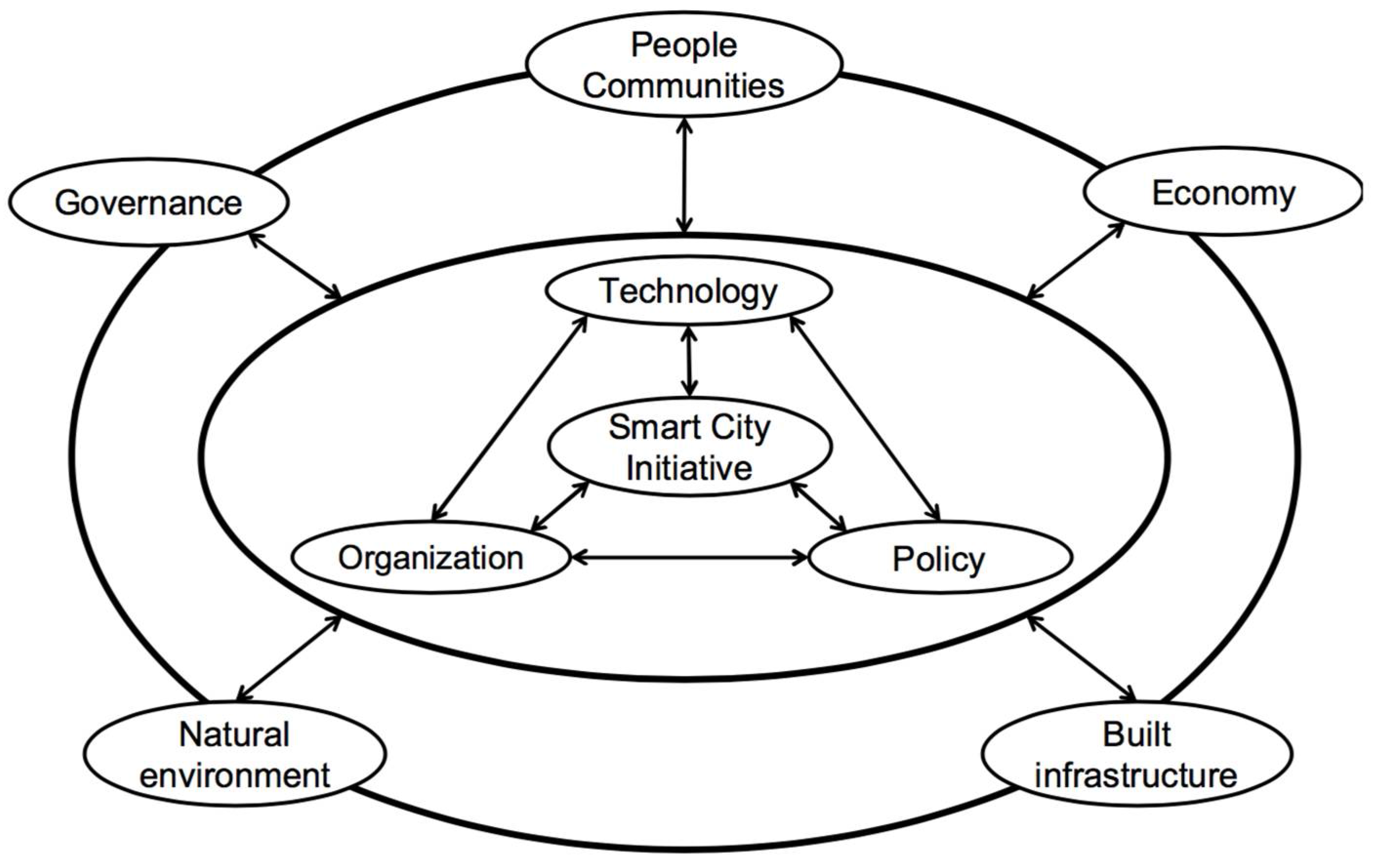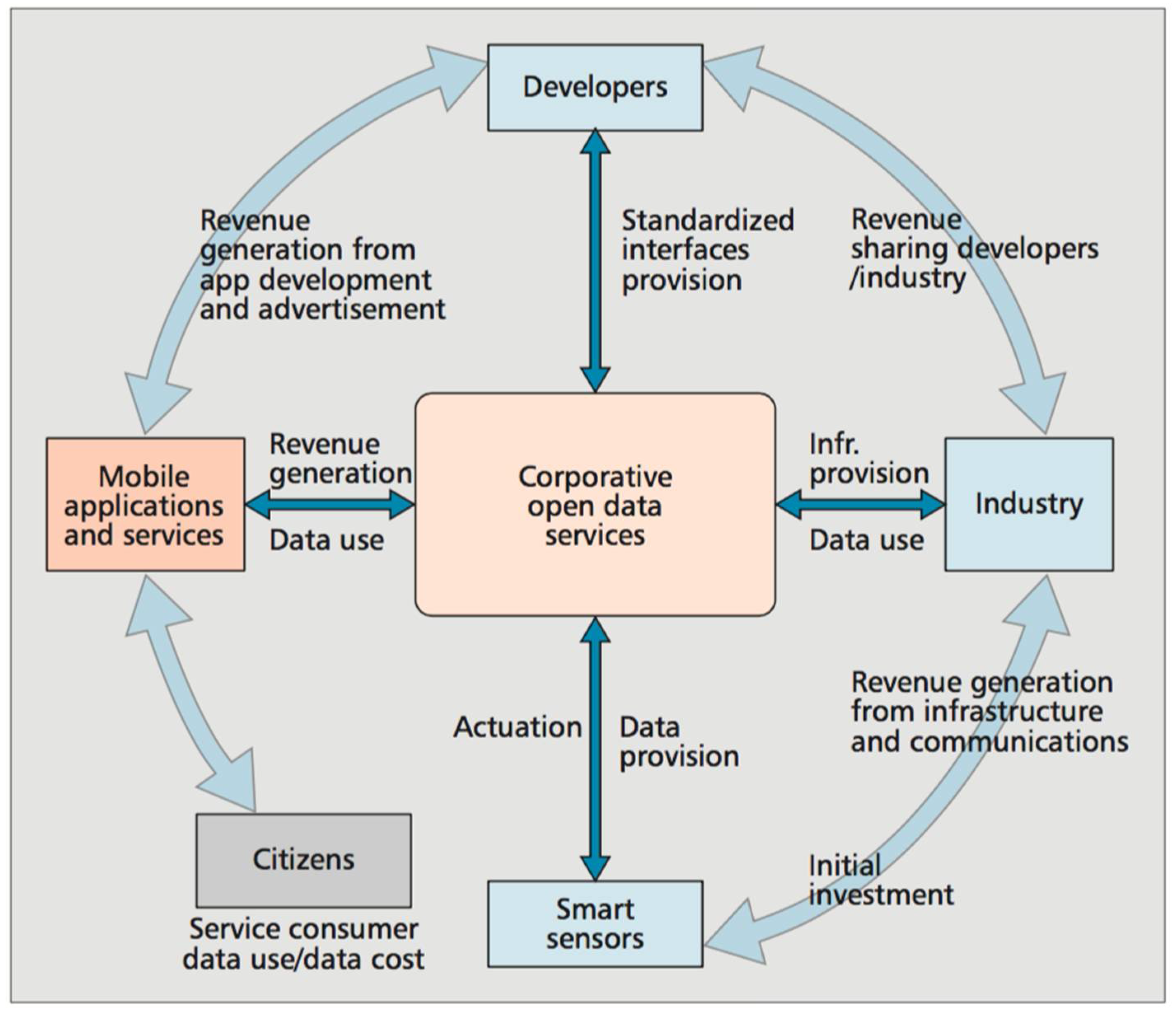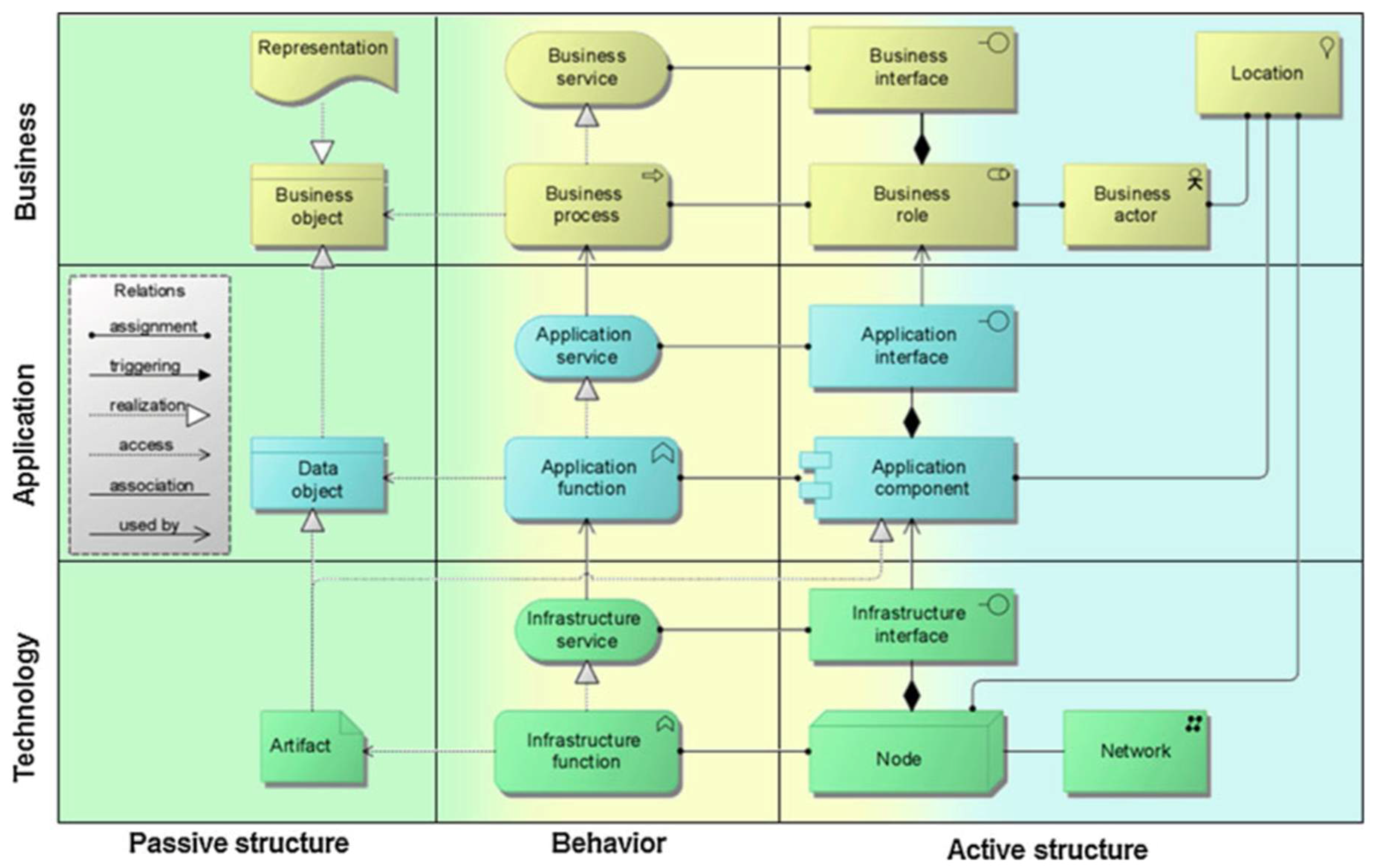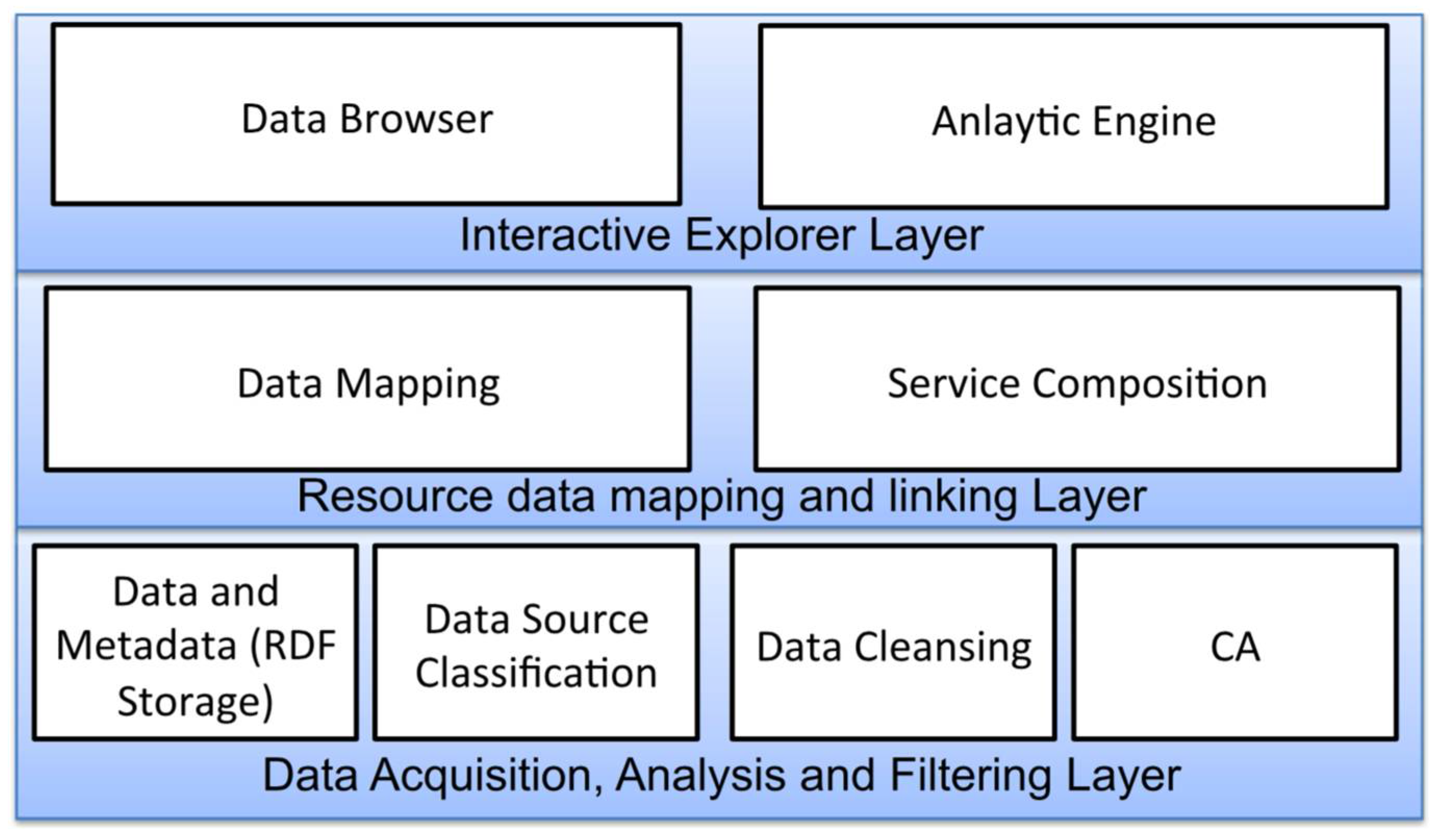Challenges in Governing the Digital Transportation Ecosystem in Jakarta: A Research Direction in Smart City Frameworks
Abstract
:1. Introduction
2. Methods
3. Results
4. Discussion
- How to improve urban traffic in Jakarta by governing the digital transportation ecosystem in smart city framework?
- To understand the digital transportation ecosystem in Jakarta from an architectural perspective.
- To identify measurable critical performance indicators for the digital transportation ecosystem in Jakarta.
- To design an analytical mechanism employing big data analytics that can provide recommendations for improving urban traffic in Jakarta.
- Sub-Research Question 1: How to describe the value network of the digital transportation ecosystem in Jakarta in consideration of the roles, interest, and business models of the involved stakeholders?
- Sub-Research Question 2: What architectural viewpoints should be described in order to comprehensively understand the digital transportation ecosystems in Jakarta? How should such architecture be formally described?
- Sub-Research Question 3: What are the most suitable performance indicators that can be used to measure and monitor the performance of the digital transportation ecosystem in Jakarta?
- Sub-Research Question 4: What are suitable model-based and data-driven analytical tools for the continuous monitoring and assessment of performance of the digital transportation ecosystem in Jakarta?
- Sub-Research Question 5: How can the results of these analytical tools be used in the governance and improvement of such digital transportation ecosystem?
5. Conclusions
Author Contributions
Conflicts of Interest
References
- United Nations. World Urbanization Prospects; Department of Economic and Social Affairs, United Nations: New York, NY, USA, 2014. [Google Scholar]
- Washburn, D.; Usman, S. Helping CIOs Understand “Smart City” Initiatives; Report; Forrester: Cambridge, MA, USA, 2010. [Google Scholar]
- Fistola, R.; Rosa, A.L.R. New Technologies for Sustainable Energy in the Smart City: The WET Theory. J. Land Use Mobil. Environ. 2014, 7, 1. [Google Scholar]
- Theodoridis, E.; Mylonas, G.; Chatzigiannakis, I. Developing an IoT Smart City Framework. In Proceedings of the 2013 Fourth International Conference on Information, Intelligence, Systems and Applications (IISA), Piraeus, Greece, 10–12 July 2013. [Google Scholar]
- Bakıcı, T.; Almirall, E.; Wareham, J. A Smart City Initiative: The Case of Barcelona. J. Knowl. Econ. 2013, 4, 135–148. [Google Scholar] [CrossRef]
- Chourabi, H.; Nam, T.; Walker, S.; Gil-Garcia, J.R.; Mellouli, S.; Nahon, K.; Pardo, T.A.; Scholl, H.J. Understanding Smart Cities: An Integrative Framework. In Proceedings of the 45th Hawaii International Conference on System Sciences, Maui, HI, USA, 4–7 January 2012; pp. 2289–2297. [Google Scholar]
- Lynn, L.E.; Heinrich, C.J.; Hill, C.J. Studying Governance and Public Management: Challenges and Prospects. J. Public Admin. Res. Theory 2000, 10, 233–262. [Google Scholar] [CrossRef]
- Albino, V.; Berardi, U.; Dangelico, R.M. Smart Cities: Definitions, Dimensions, Performance, and Initiatives. J. Urban Technol. 2015, 22, 3–21. [Google Scholar] [CrossRef]
- Benevolo, C.; Dameri, R.P.; D’Auria, B. Smart Mobility in Smart City. Lect. Notes Inf. Syst. Organ. 2016, 11, 13–28. [Google Scholar]
- Djahel, S.; Doolan, R.; Muntean, G.-M. A Communications-Oriented Perspective on Traffic Management Systems for Smart Cities: Challenges and Innovative Approaches. IEEE Commun. Surv. Tutor. 2015, 17, 125–151. [Google Scholar] [CrossRef]
- Lee, D. Absolute Traffic: Infrastructural Aptitude in Urban Indonesia. Int. J. Urban Reg. Res. 2015, 39, 234–250. [Google Scholar] [CrossRef]
- Jakarta Local Government. Jakarta Urban Transport Problems and Their Environmental Impacts. Available online: https://www.ui.ac.id/download/apru-awi/jakarta-local-goverment.pdf (accessed on 21 March 2018).
- TomTom. TomTom Traffic Index. 2017. Available online: https://www.tomtom.com/en_gb/trafficindex/ (accessed on 19 March 2018).
- Dinita, A.P.; Maharani Karlina, C.H.; Jimmy, T. From Smart City to Open City: Lessons from Jakarta Smart City; Centre for Innovation Policy and Governance: Jakarta Pusat, Indonesia, 2016. [Google Scholar]
- Kusumaningrum, M.C. Modeling and Analyzing Digital Business Ecosystems. Master’s Thesis, University of Twente, Enschede, The Netherlands, 2017. [Google Scholar]
- Shin, D. A socio-technical framework for Internet-of-Things design: A human-centered design for the Internet of Things. Telemat. Inform. 2014, 31, 519–531. [Google Scholar] [CrossRef]
- Schleicher, J.M.; Vögler, M.; Dustdar, S.; Inzinger, C. Enabling a Smart City Application Ecosystem. IEEE Internet Comput. 2016, 20, 58–65. [Google Scholar] [CrossRef]
- Iacob, M.E.; Meertens, L.O.; Jonkers, H.; van Sinderen, M.J. From enterprise architecture to business models and back. Soft. Syst. Model. 2012, 13. [Google Scholar] [CrossRef]
- Rathore, M.M.; Ahmad, A.; Paul, A.; Jeon, G. Efficient Graph-Oriented Smart Transportation using Internet of Things generated Big Data. In Proceedings of the 11th International Conference on Signal-Image Technology & Internet-Based Systems, Bangkok, Thailand, 23–27 November 2015. [Google Scholar] [CrossRef]
- Kitchin, R. The real-time city? Big data and smart urbanism. GeoJournal 2014, 79, 1–14. [Google Scholar] [CrossRef]
- Petrolo, R.; Loscri, V.; Mitton, N. Towards a smart city based on cloud of things, a survey on the smart city vision and paradigms. Trans. Emerg. Telecommun. Technol. 2015, 1–11. [Google Scholar] [CrossRef]
- Anthopoulos, L. Defining Smart City Architecture for Sustainability. Electron. Gov. Electron. Particip. 2015, 140–147. [Google Scholar] [CrossRef]
- Gaur, A.; Scotney, B.; Parr, G.; McClean, S. Smart City Architecture and its Applications based on IoT. Procedia Comput. Sci. 2015, 52, 1089–1094. [Google Scholar] [CrossRef]
- Jalali, R.; El-khatib, K.; McGregor, C. Smart City Architecture for Community Level Services through the Internet of Thing. In Proceedings of the 18th International Conference on Intelligence in Next Generation Networks, Paris, France, 17–19 February 2015; pp. 108–113. [Google Scholar]
- Zygiaris, S. Smart City Reference Model: Assisting Planners to Conceptualize the Building of Smart City Innovation Ecosystems. J. Knowl. Econ. 2012, 2. [Google Scholar] [CrossRef]
- Vilajosana, I.; Llosa, J.; Martinesz, B.; Domingo-Prieto, M.; Abgles, A.; Vilajosana, X. Bootstrapping Smart Cities through a Self-Sustainable Model Based on Big Data Flows. IEEE Commun. Mag. 2013, 51, 128–134. [Google Scholar] [CrossRef]
- Ghanbari, A.; Alvarez, O.; Markendahl, J. MTC Value Network for Smart City Ecosystems. In Proceedings of the Wireless Communications and Networking Conference Workshops (WCNCW), Doha, Qatar, 3–6 April 2016. [Google Scholar]
- Gretzel, U.; Werthner, H.; Koo, C.; Lamsfus, C. Conceptual foundations for understanding smart tourism ecosystem. Comput. Hum. Behav. 2015, 50, 558–563. [Google Scholar] [CrossRef]
- Sherly, J.; Somasundareswari, D. Internet of Things Based Smart Transportation Systems. Int. Res. J. Engine Technol. 2015, 2, 7. [Google Scholar]
- Xiong, Z.; Sheng, H.; Rong, W.G.; Cooper, D.E. Intelligent transportation systems for smart cities: A progress review. Sci. China Inf. Sci. 2012, 55, 2908–2914. [Google Scholar] [CrossRef]
- Khazaei, H.; Zareian, S.; Veleda, R.; Litoiu, M. Sipresk: A Big Data Analytic Platform for Smart Transportation. SmartCity 2016, 360, 419–430. [Google Scholar]
- Audouin, M.; Razaghi, M.; Finger, M. How Seoul used the ‘T-Money’ smart transportation card to re-plan the public transportation system of the city; implications for governance of innovation in urban public transportation systems. In Proceedings of the 8th TransIST Symposium, Istanbul, Turkey, 9–12 November 2015. [Google Scholar]
- Stefansson, G.; Lumsden, K. Performance issues of Smart Transportation Management systems. Int. J. Product. Perform. Manag. 2009, 68, 54–70. [Google Scholar] [CrossRef]
- Joshi, M.; Vaidya, A.; Deshmukh, M. Sustainable Transport Solutions for the Concept of Smart City. Sustain. Energy Transp. 2018, 1, 21–42. [Google Scholar]
- Peppard, J.; Rylander, A. From Value Chain to Value Network: Insights for Mobile Operators. Eur. Manag. J. 2006, 24, 128–131. [Google Scholar] [CrossRef] [Green Version]
- Fritscher, B.; Pigneur, Y. Business IT Alignment from Business Model to Enterprise Architecture. In Proceedings of the CAiSE 2011 Workshops, London, UK, 20–24 June 2011. [Google Scholar]
- Targio Hashem, I.A.; Hashem, T.; Chang, V.; Anuar, N.B.; Adewole, K.; Yaqoob, I.; Gani, A.; Ahmed, E.; Chirome, H. The Role of Big Data in Smart City. Int. J. Inf. Manag. 2016, 36, 748–758. [Google Scholar] [CrossRef]
- Khan, Z.; Anjum, A.; Soomro, K.; Tahir, M.A. Towards cloud based big data analytics for smart future cities. J. Cloud Comput. 2014, 4. [Google Scholar] [CrossRef] [Green Version]




| Author | Perspective | Description |
|---|---|---|
| [21] | Technological | Layers of smart city platform, consists of data sources, IoT platforms, platform agnostic management, monitoring and governance, and smart city application and tools. |
| [22] | Technological | Layers of smart city ICT architecture, consists of natural environment, hard infrastructure (non-ICT), hard infrastructure (ICT-based), services, and soft infrastructure. |
| [23] | Technological | Multilevel smart city architecture, consists of sensors, communication service, data collection, data processing, data integration and reasoning, device control and alerts, communication services, and customized services. |
| [24] | Technological | Layers of smart city ICT architecture, consists of sensing layer, network layer, and control & services layer. |
| [25] | Governance | Analytical framework to govern smart city’s innovation ecosystem, represented on smart city ecosystem layers that consists of city layer, the green city layer, the interconnection layer, the instrumentation layer, the open integration layer, the application layer, and the innovation layer. |
| [26] | Governance | Smart city architecture that represents relationship between involved stakeholders with central focus on corporative open data services. |
| [27] | Governance | Value network of Machine Type Communication (MTC) in smart city ecosystems, specifically for stakeholders in telecommunication industry. |
| [28] | Governance | Conceptualization of smart tourism ecosystem concerning technological aspect, value exchanged between involved stakeholders and business model aspect. |
| Author | Perspective | Description |
|---|---|---|
| [29] | Technological | Development of intelligent transportation system based on internet of things technology to provide real-time traffic controlling and monitoring. |
| [19] | Technological | Development of real-time intelligent transportation system using graph-oriented approach. The proposed system utilizes big data analytic to process the data from IoT devices. |
| [30] | Technological | Review intelligent transportation system related research around the world in technological perspective. |
| [31] | Technological | Big data analytics platform to analyzes the urban transportation data to get the understanding of traffic patterns. |
| [32] | Governance | This study explores the changes of the governance structure of public transportation system in Seoul to supports the design and implementation of smart card public transportation system (T-Money). |
| [33] | Governance | Development of a conceptual model of smart transportation management system to analyze the influence of the included factors in distribution activities and identifies the management issues. |
| [34] | Governance | Development of sustainable transportation scenario in the context of smart city for India, based on the case studies in developed countries. |
© 2018 by the authors. Licensee MDPI, Basel, Switzerland. This article is an open access article distributed under the terms and conditions of the Creative Commons Attribution (CC BY) license (http://creativecommons.org/licenses/by/4.0/).
Share and Cite
Mukti, I.Y.; Prambudia, Y. Challenges in Governing the Digital Transportation Ecosystem in Jakarta: A Research Direction in Smart City Frameworks. Challenges 2018, 9, 14. https://doi.org/10.3390/challe9010014
Mukti IY, Prambudia Y. Challenges in Governing the Digital Transportation Ecosystem in Jakarta: A Research Direction in Smart City Frameworks. Challenges. 2018; 9(1):14. https://doi.org/10.3390/challe9010014
Chicago/Turabian StyleMukti, Iqbal Yulizar, and Yudha Prambudia. 2018. "Challenges in Governing the Digital Transportation Ecosystem in Jakarta: A Research Direction in Smart City Frameworks" Challenges 9, no. 1: 14. https://doi.org/10.3390/challe9010014





